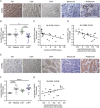Induction of cardiac FGF23/FGFR4 expression is associated with left ventricular hypertrophy in patients with chronic kidney disease
- PMID: 26681731
- PMCID: PMC6388939
- DOI: 10.1093/ndt/gfv421
Induction of cardiac FGF23/FGFR4 expression is associated with left ventricular hypertrophy in patients with chronic kidney disease
Abstract
Background: In chronic kidney disease (CKD), serum concentrations of fibroblast growth factor 23 (FGF23) increase progressively as glomerular filtration rate declines, while renal expression of the FGF23 coreceptor Klotho decreases. Elevated circulating FGF23 levels are strongly associated with mortality and with left ventricular hypertrophy (LVH), which is a major cause of cardiovascular death in CKD patients. The cardiac FGF23/FGF receptor (FGFR) system and its role in the development of LVH in humans have not been addressed previously.
Methods: We conducted a retrospective case-control study in 24 deceased patients with childhood-onset end-stage renal disease (dialysis: n = 17; transplanted: n = 7), and 24 age- and sex-matched control subjects. Myocardial autopsy samples of the left ventricle were evaluated for expression of endogenous FGF23, FGFR isoforms, Klotho, calcineurin and nuclear factor of activated T-cells (NFAT) by immunohistochemistry, immunofluorescence microscopy, qRT-PCR and western blotting.
Results: The majority of patients presented with LVH (67%). Human cardiomyocytes express full-length FGF23, and cardiac FGF23 is excessively high in patients with CKD. Enhanced myocardial expression of FGF23 in concert with Klotho deficiency strongly correlates with the presence of LVH. Cardiac FGF23 levels associate with time-averaged serum phosphate levels, up-regulation of FGFR4 and activation of the calcineurin-NFAT signaling pathway, an established mediator of cardiac remodelling and LVH. These changes are detected in patients on dialysis but not in those with a functioning kidney transplant.
Conclusions: Our results indicate a strong association between LVH and enhanced expression levels of FGF23, FGFR4 and calcineurin, activation of NFAT and reduced levels of soluble Klotho in the myocardium of patients with CKD. These alterations are not observed in kidney transplant patients.
Keywords: Klotho; chronic kidney disease; fibroblast growth factor 23; fibroblast growth factor receptor 4; left ventricular hypertrophy.
© The Author 2015. Published by Oxford University Press on behalf of ERA-EDTA. All rights reserved.
Figures






Comment in
-
Connecting the dots on fibroblast growth factor 23 and left ventricular hypertrophy.Nephrol Dial Transplant. 2016 Jul;31(7):1031-3. doi: 10.1093/ndt/gfv445. Epub 2016 Jan 18. Nephrol Dial Transplant. 2016. PMID: 26786549 Free PMC article.
References
-
- Eckardt KU, Coresh J, Devuyst O et al. . Evolving importance of kidney disease: from subspecialty to global health burden. Lancet 2013; 382: 158–169 - PubMed
-
- Go AS, Chertow GM, Fan D et al. . Chronic kidney disease and the risks of death, cardiovascular events, and hospitalization. N Engl J Med 2004; 351: 1296–1305 - PubMed
-
- Parekh RS, Carroll CE, Wolfe RA et al. . Cardiovascular mortality in children and young adults with end-stage kidney disease. J Pediatr 2002; 141: 191–197 - PubMed
Publication types
MeSH terms
Substances
Grants and funding
LinkOut - more resources
Full Text Sources
Other Literature Sources
Medical
Miscellaneous

